How to Get a Horse Ready to Ride
Get a leg up on the basics of horse riding with safety tips and step-by-step advice.
If you've never ridden a horse before, it's common to go a little too far in one direction or the other. You're either scared silly ("That animal is HUGE!"), or feel like it's going to be a breeze ("Tallyho, Silver!"). After all, the horse is doing all the work, right?
Riding is a sport, meaning it's quite physical and can be enjoyed on a number of skill levels. That's one of the many wonderful things about it! This article helps safely get beginners in the saddle (and keep them there) by covering these basics:
Horse Riding Safety Tips
We want you to feel as relaxed as possible about your first rides, but there are some safety rules you should always follow.

Never ride without a helmet. It's simply not worth the risk. (Source: Pixabay)
Horses are one of the best things in the world – no argument from the Horse Rookie team, here–but they are also tall, heavy, and afraid of things like plastic bags.
- Helmets are NOT negotiable: Before you get on, make sure you are wearing a properly fitting horse riding helmet. It can save your life in the event of an #unplanneddismount, so make sure yours fits well. You also need to know how often to replace your horseback riding helmet.
- Stay alert: Riding is super fun, and when you're first learning, it's easy to get distracted. You are dealing with a living, breathing animal who might behave unpredictably. You'll learn to understand "horse talk" better as you progress, but keep your eyes open and be aware of your horse, other horses around you, and the surroundings. Your toes (and pride) will be happier for it.
- Protect your feet: Speaking of toes, proper boots are a must. You don't need to purchase new ones for your first riding experience, but if you keep riding you'll want to invest in one of our 11 best boots for horseback riding lessons.
Safety should come first, for rookies and pros, alike. Check out our article Horseback Riding Safety Equipment That's Worth Every Penny, and our 12 best everyday horse riding boots.
Return to Top
How to Ride a Horse Step by Step
Learning to ride a horse can look very complicated, and there is a lot that goes into riding well. But breaking down each element into baby steps helps riders of all ages become proficient equestrians.
How to Get on a Horse for Beginners
One of the coolest things about horses is that they are so tall. One of the scary things about horses is that they are, again, so tall. Yikes! (Don't even get us started on these 6 tall horse breeds…)
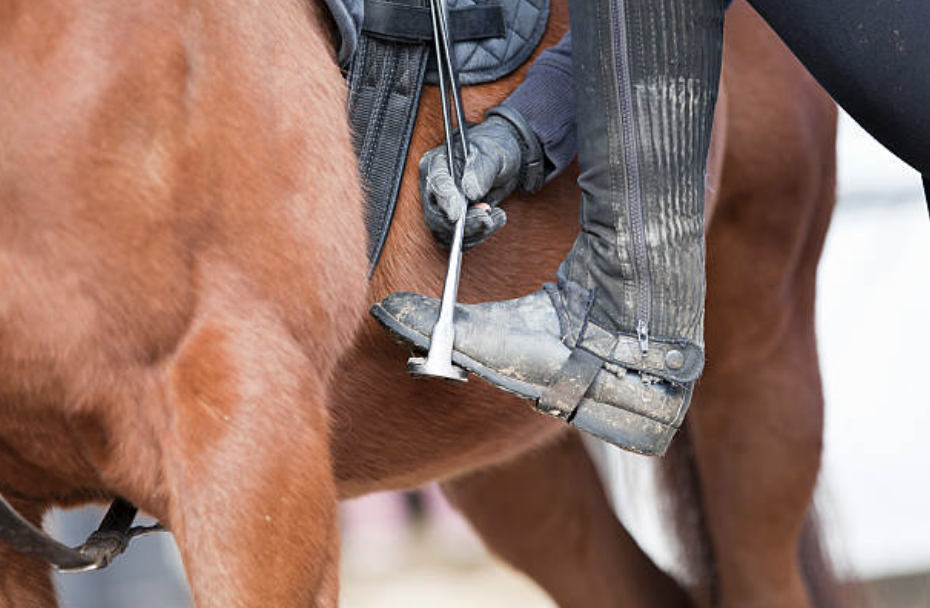
The first step to every ride? Getting on! (Source: iStock)
How are you supposed to get up there? Good news. With a little practice, mounting a horse is easy:
- Have someone hold your horse for you while you get on.
- Always check your girth! If it's not snug enough, the saddle can "roll" when you try to get on.
- Stand on the horse's left side. (It's customary to work from this side of the horse, so it will be accustomed to this.)
- Hold the ends of the reins in your left hand, just in front of the saddle, but keep them loose. (Reins are what you use to steer your horse, so you'll want to have them ready.)
- Put your left foot in the stirrup. Make sure the ball of your foot is on the stirrup vs. sticking your foot all the way through to the heel.
- Put your weight on your left foot and "step up" to a standing position. (Your right leg will be hanging next to your left.)
- Swing your right leg up and over the horse's rump, being careful not to accidentally kick them on the way.
- Sit down in the saddle as gently as possible.
- Adjust your stirrups to the proper length, or have your trainer do it for you.
- Put your right foot in the other stirrup. Remember to center the ball of your foot on the stirrup, not your toe or heel.
- Congrats! You're now on a horse.
Here is a helpful video showing how to mount a horse from the ground. This person is using a Western saddle.
You may also use a mounting block, which is a wooden or plastic stepping stool designed to bring you up to the level of the stirrup and make it easier to get on. The mounting process, itself, will be the same.
Here's a video that shows how to safely use a mounting block. This person is using an English saddle.
Mounting your horse is a lot easier if you're wearing the right pants. Check out the 9 Best Breech Brands for no-regrets apparel.
Return to Top
How to Stop a Horse for Beginners
As fun as your first ride will be, you'll want to bring your horse to a stop at some point. Just remember — you'll be slowing down and then stopping. There shouldn't be any "slamming on the brakes" while you're in the saddle.
- First, you'll want to make sure that you are steady in the saddle.
- Sink your weight into the seat.
- Lean back a little, and firm up your legs.
- There's no shame in holding on to the horn or the front of the saddle.
- Let your horse know you'd like to slow down by saying "Whoa," in a normal tone of voice. (You don't need to yell – you're just a couple of feet away from their ears.)
- Pull back gently on the reins. Don't keep pulling at them like you're pulling a rope. Instead, alternate tightening and releasing the pressure. Remember, the bit is in their mouth, and it's sensitive!
- Once your horse has stopped, release the reins and give his neck a nice pat as a reward.
If you're new to riding, check out our 6 best horse bits for beginners.
Here's a helpful video about how to stop a horse:
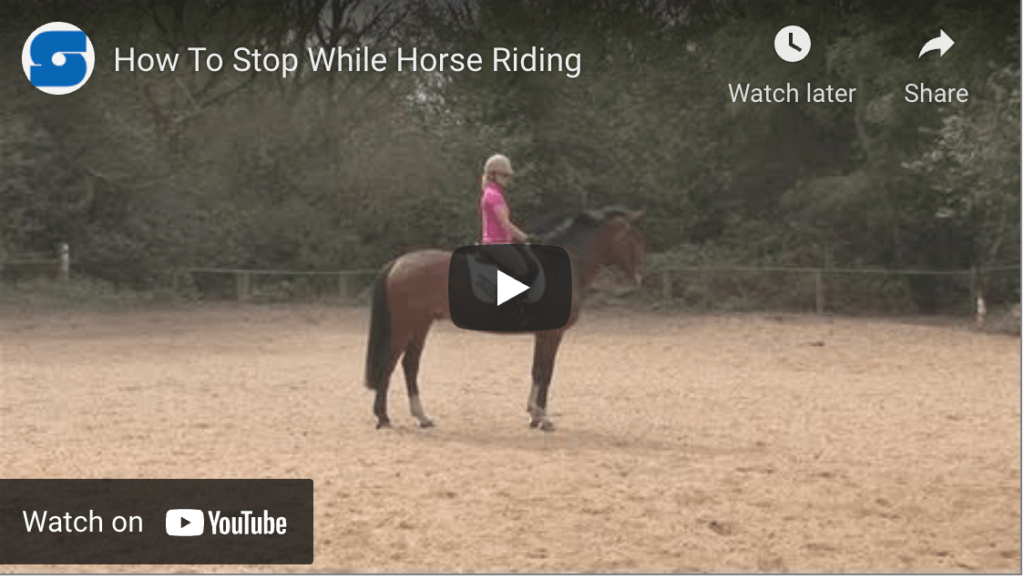
Click to view video!
Sometimes things don't go as planned. Check out our Equestrian Hit Air Vest Review to see how this innovative technology can protect you.
Return to Top
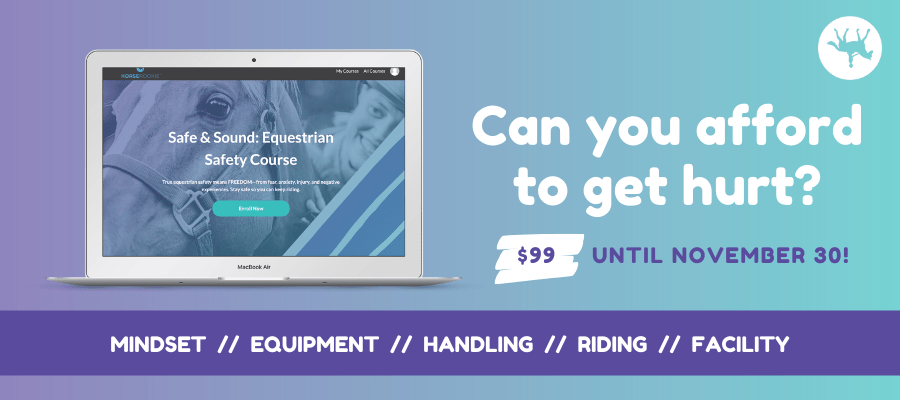
How to Walk on a Horse for Beginners
Once you've successfully gotten up into the saddle, you're ready to cue your horse to walk. Remember to relax as much as possible. Tight muscles will make everything more difficult.
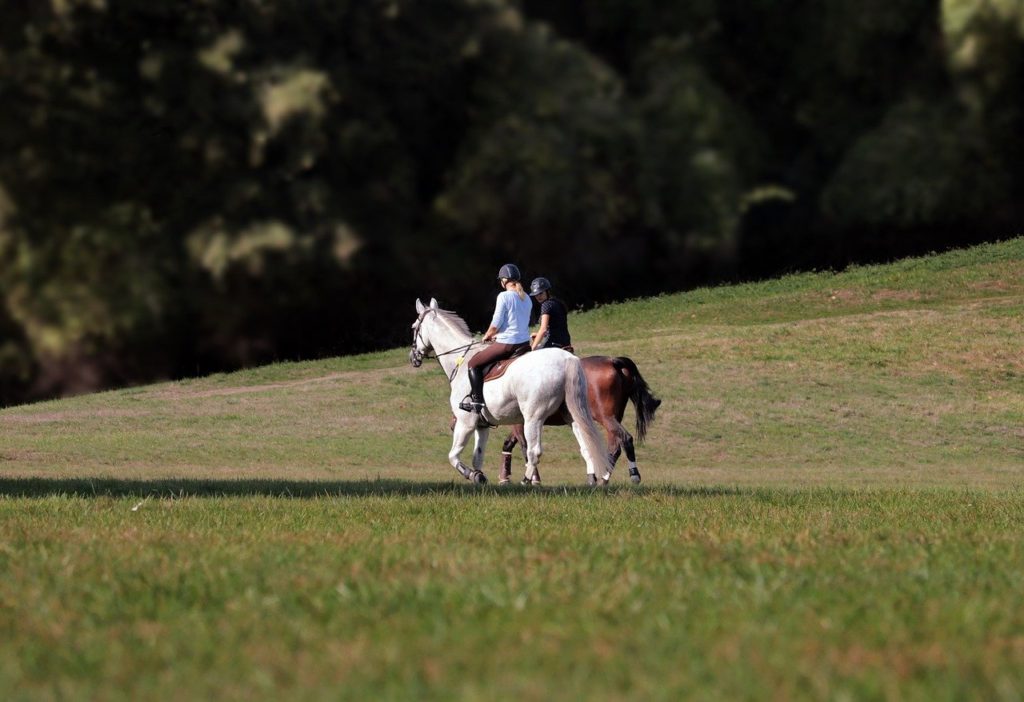
Source: Pixabay
Here's how to walk on a horse:
- Make sure you have both of your feet placed comfortably in the stirrups.
- Hold the reins in your hand or hands, as your instructor directs. (Western riders usually use one hand, while English riders use two.)
- Sit deep and relaxed in the saddle, and keep the reins slightly loose. You don't want to pull back on your horse's mouth as you ask them to move forward.
- Give your horse a gentle squeeze (not a kick) with your lower legs to signal he should begin walking. If you have a very quiet or lazy horse, you may need to give him a couple of soft bumps with your heels.
- Sit up tall, hold your head up straight, and look between your horse's ears (not at the ground).
- Try not to squeeze repeatedly with your legs once the horse is walking. Keep your legs long, quiet, and with weight firmly down in your heels.
- Listen to your instructor about how to steer with your reins and legs.
Here is a helpful video about how to walk on a horse:
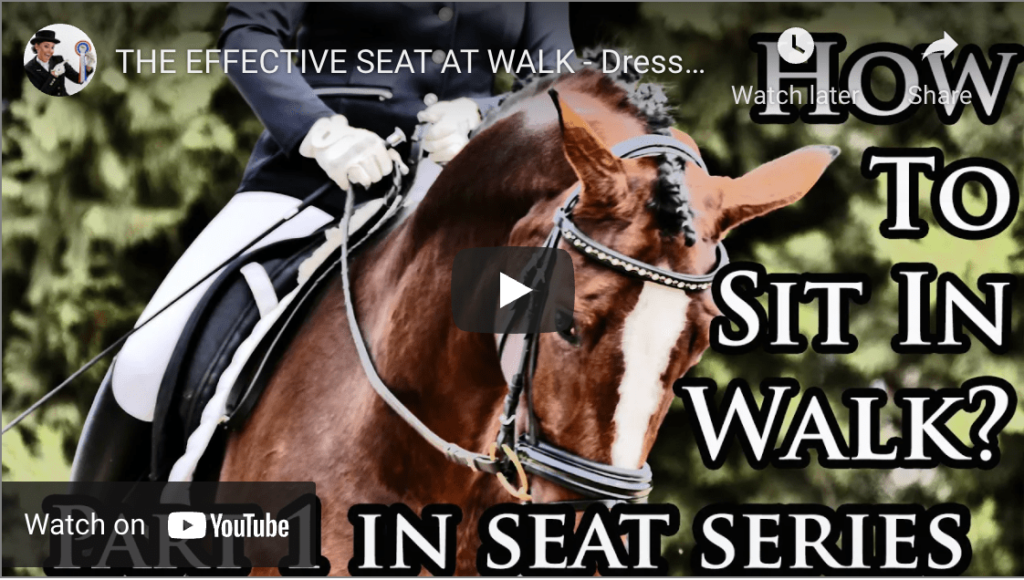
Click to watch video!
If you're new to horses, be sure to ride the right horse. Read about the 4 Best Horse Breeds for Beginners.
Return to Top
How to Trot on a Horse for Beginners
Trotting is similar to jogging for a person. With each stride, your horse will be bouncing up into the air a little–and that means that you'll be bouncing a little, too.
If walking on a horse feels like the gentle swaying of a boat on the water, trotting is going to feel like the waves are coming up a little higher. (Or, a lot higher, in the beginning.)
Here's how to stay "afloat."
- From a walk, gently squeeze your legs to ask the horse to move into a trot. If it continues walking, you may need to lightly bump with your heels.
- Don't be afraid to hold on to the horn or front of the saddle to help steady yourself. You can also attach a grab strap to your English or Western saddle so you have something sturdy to hold onto. These straps are inconspicuous, inexpensive, and give you some additional security while you're just starting out.
- Trotting may feel awkward, until you get the hang of it, so don't get frustrated if it's hard to manage at first.
- Try not to squeeze with your knees or legs to hold on, even if it's your first instinct. Relaxing makes things easier!
- Let yourself sink into the saddle, and let your legs continue hanging long, quiet, and with weight in your heels.
- Don't use the reins to help you balance, as that will hurt your horse's mouth. If you need to steady yourself, use a grab strap or the saddle horn (if riding Western style).
- Keep looking forward through your horse's ears and sitting up nice and tall.
- Start by trotting for a few steps at a time in the beginning, then work your way up to longer periods of trotting.
- There's a lot to coordinate at first, but you'll get the hang of it with practice!
Here's a helpful video showing how to trot on a horse:
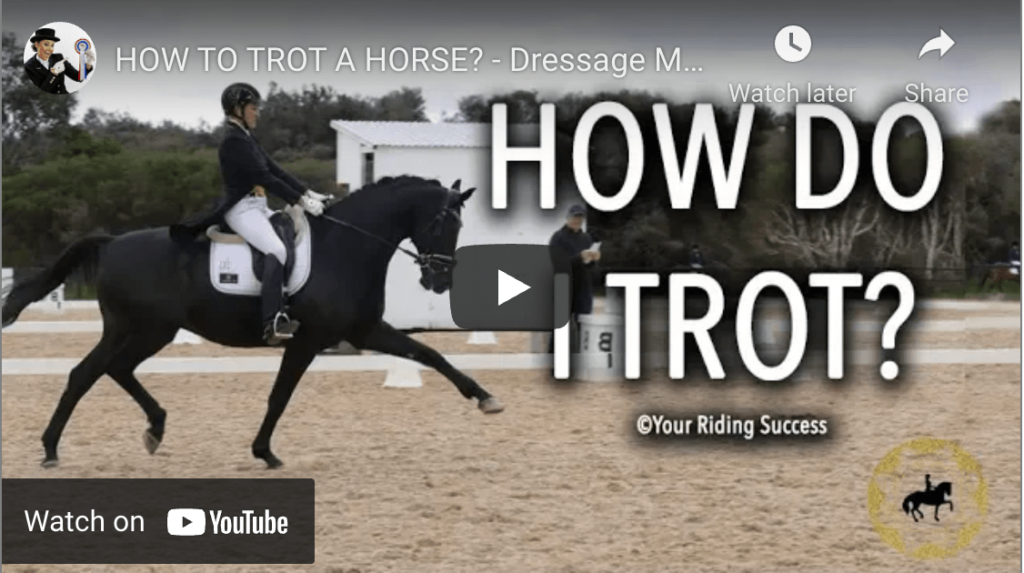
Click to watch video
Return to Top
How to Post on a Horse for Beginners
It's a funny sounding term, but "posting" on your horse will make it a lot easier for you as you learn and improve your riding skills.
Posting involves rising slightly out of the saddle matching your horse's natural movement and keeps you from bouncing while the horse trots. (English and Western riders can post the trot.)
- You'll use your knees and upper leg muscles the most when you're posting.
- While you're experiencing the one-two-one-two beat of the trot, you'll notice that you are being bounced out of the saddle when your horse pushes off with their back legs. "Posting" means rising and sitting with that two-beat gait.
- Use your knees and thighs as the pivot point to swivel upward and forward from the saddle.
- You'll rise when the horse's outside shoulder (the one next to the rail or arena wall) moves forward and sit when it moves back.
- Keep your eyes up, except for occasionally glancing down to check that you're rising properly with the horse's shoulder.
- Remember to sit gently so you don't hurt the horse's back.
- Posting gets easier the more you do it and the more you develop the correct muscles.
Here's a helpful video about how to post on a horse (aka riding trot):

Click to view video!
Return to Top
How to Sit the Trot Without Bouncing for Beginners
Watching a more experienced rider trot along, without bouncing, may look like magic.
Once you've tried trotting for the first time, it's hard to imagine how they do it. They must have thighs of steel, or velcro on their saddle seat! In actuality, they've simply practiced a LOT.
Here's how to start improving:
- The secret to not bouncing at the trot is learning to relax and not tense up.
- Think about walking along holding a really full cup of water without a lid. If you don't want it to spill, you have to let your wrist relax and your elbow bend. It's the same way with riding at the trot.
- You have to relax your body and try not to grip hard with your legs.
- Let your legs hang long, quiet, and with weight down in your heels.
- Imagine that you have that cup of water strapped to the center of your chest, and you're trying to keep it from spilling all over you and your trusty steed.
- Once you learn to sit the trot without squeezing, other pieces of the puzzle will fall into place.
- You'll soon learn to coordinate your hands and weight while you're in the saddle.
Here are two helpful videos about how to sit the trot without bouncing:
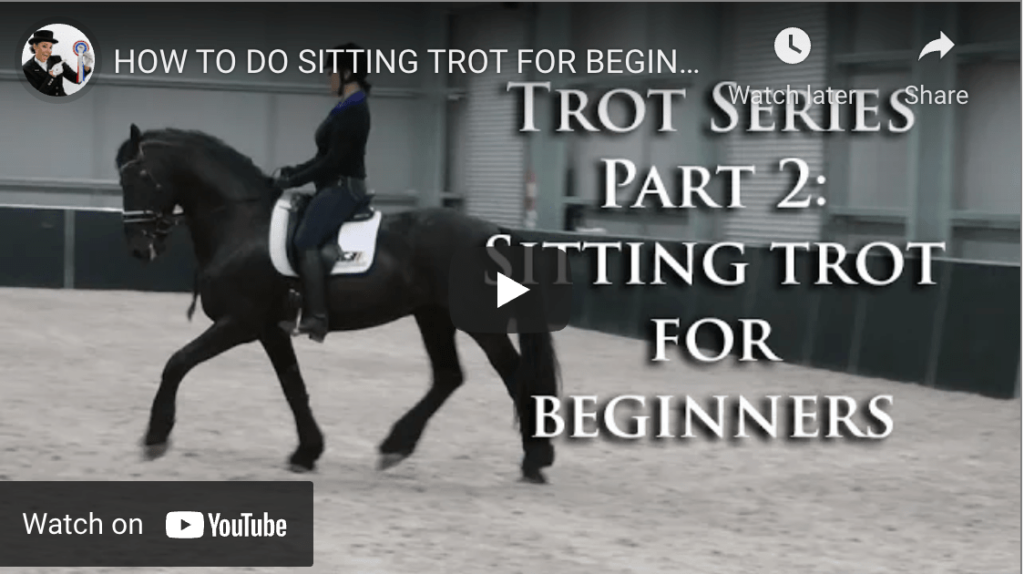
Click to view video!
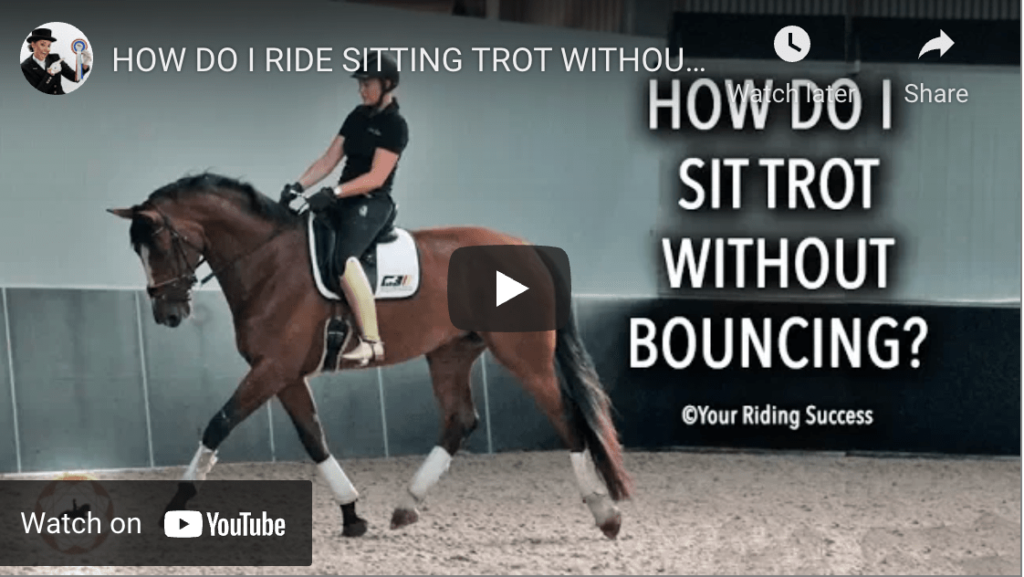
Click to watch video!
Return to Top
New to horses? Check out our article about What to Wear Horseback Riding (With Pictures).
How to Canter on a Horse for Beginners
When you're ready to canter, you'll find that it's a little easier to stay seated in the saddle, compared to trotting.
Cantering has three "beats," or foot falls, and it feels a bit like you're sitting on a rocking horse. (A really cute, furry rocking horse that nickers.)
Here's how to canter on a horse:
- Start cantering from a trot.
- It's easy to make the mistake of trotting faster and faster before you begin to canter, but you want to make a clear transition from trot to canter without trotting quickly.
- Asking for the canter can vary from horse to horse, so ask your trainer what cues your horse understands.
- Typically, you will move your outside leg back a few inches and then squeeze gently with both legs to ask for the canter.
- Keep yourself balanced in the center of the saddle and let your hips move back and forth with the horse.
- Don't pull on the reins (unless it's going too fast and you want to slow down). Instead, let your horse move his head freely and focus on keeping a deep seat.
- When you're ready to slow down, gently pull back on the reins to let your horse know it's time to trot again.
Here's a helpful video about how to canter on a horse:

Click to watch video!
Return to Top
Helmets are a must when you canter–or do any other gait on your horse. See our favorite helmets on the Horse Rookie Riding Essentials Amazon List.

How to Gallop on a Horse for Beginners
Galloping is the next step up from cantering.
It's essential that you have control of your horse at all lower speeds before you move on to the fastest gait.

Source: Pixabay
Galloping is only for experienced riders.
It can be difficult to control and stop your horse, and you can both get hurt.
Here's how to gallop on a horse:
- Galloping is very similar to cantering, except the horse stretches out to cover more ground more quickly. Your horse will need to stretch out his head and neck so his legs can extend.
- Start from a regular canter, ensuring you have full control and feel balanced.
- Cue for a gallop by leaning slightly forward and rising out of the saddle. (Think of it like a lesser version of what you see racehorse riders look like.)
- Move your hands slightly up the horse's neck.
- Squeeze your legs gently to ask for more speed and extension.
- Keep your weight firmly on your feet in the stirrups so you can balance with your butt slightly out of the saddle.
Here's a helpful video about how to gallop on a horse:

Click to watch video!
Return to Top
How to Jump on a Horse for Beginners
Jumping can be really fun — when you're ready! You might get to try out small jumps in the riding ring with an instructor or when you're out on a trail ride.
Here are some horse jumping tips for beginners:
- Jumping feels like a very big and bouncy canter stride. Your horse will push off strongly with its back legs, tuck up its front legs, and go over the jump.
- It's important to lean slightly forward over the jump to help keep your balance and not interfere with it's mouth.
- Maintain strong and secure legs and seat, but don't grip tightly.
- Keep your eyes UP, not looking down at the ground or at the jump.
- Move your hands slightly forward on the horse's neck to avoid pulling on his mouth.
- Once you've cleared the jump, sit back down in the saddle and return to a normal trot or canter position.
- It takes practice to get used to the rhythm of a horse that is going to jump. Be prepared to do lots of drills with your instructor and perhaps learn to go over small jumps without using your stirrups to help you balance.
Here are two helpful videos showing how to jump on a horse:
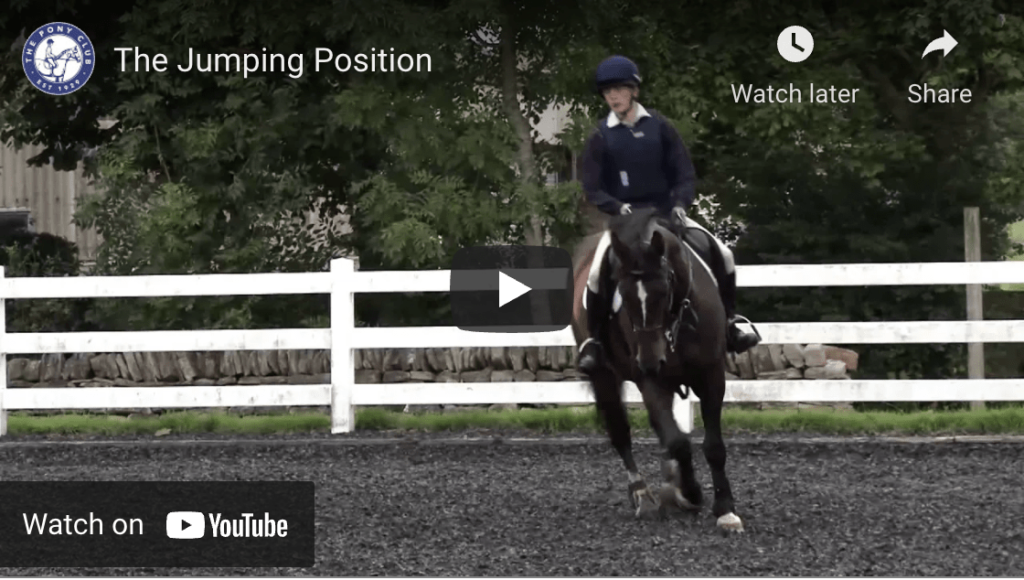
Click to view video
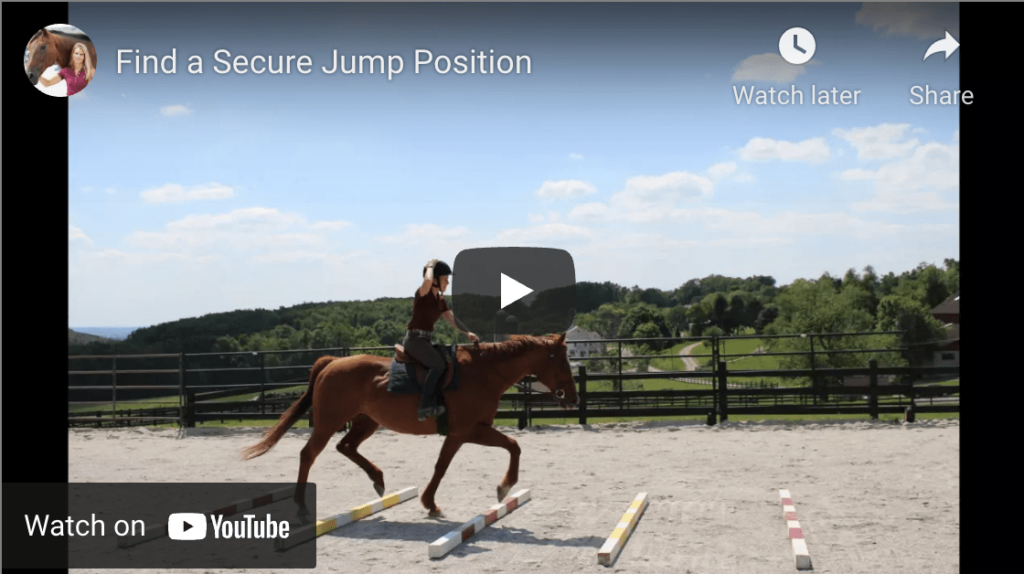
Click to view video!
Jumping can be really fun… with the right stirrups. Check out our 10 Best Stirrups for Jumping.
Return to Top
How to Dismount a Horse for Beginners
When you're ready to dismount, you'll need to make sure that your horse will not move away as you get off.
- Bring your horse to a complete stop, and make sure you are away from other horses.
- Make sure you have a firm hold on the reins, but don't pull on your horse's mouth.
- Kick your feet free of your stirrups and lean forward.
- Swing your right leg up and over your horse's back. Be sure not to accidentally kick your horse on the bum!
- Slide to the ground on your horse's left side.
- Remember: Dismount on the left side of the horse.
Here's a helpful video showing how to dismount a horse:

Click to view video!
Return to Top
Horse Riding Tips for Beginners
Starting your horse riding journey is exciting, and there are a few basic tips that'll help you have fun and stay safe.
- Always wear a helmet. Every ride, every time.
- Wear boots with heels… and keep those heels down!
- Sit up straight with shoulders back.
- Look where you want to go.
- Keep your fingers closed around the reins.
- Work with a trusted trainer in regular lessons.
- Ride a horse that's well trained and appropriate for your level of experience.
- Learn how to keep your nerves in check so you can focus on your position and your horse.
- Start slow and become confident at each skill before advancing.
- Develop a solid position and seat at all speeds.
Want to learn more? Check out these articles:
- What to wear horseback riding (with pictures)
- 33 Things you can do today to calm your horse riding nerves forever
- Say yes to the horse: 11 best breeds for first time owners
Return to Top
Common Beginner Horse Riding Mistakes
There are several common mistakes that new riders make, including:
- Not wearing a helmet: We've said it before, and we'll say it again. Helmets are a MUST!
- Not keeping your shoulders back: It's good to be relaxed, but it's not good to slump. Leaning your shoulders and head forward puts a lot of pressure on your neck and spine, throws you off balance, and keeps you from looking ahead as you ride.
- Kicking your horse: Often, the horse you will be learning to ride on will be calm and need a little encouragement to go forward. If you do need to give them a little extra motivation though, don't start thumping the horse in the ribs with all your might. Talk to your instructor about other ways to get them to move along. (If you need spurs, check out our 5 Best Spurs for Beginners–and learn how to use them properly.)
- Using your reins for balance: Reins are to help communicate with your horse, not to hold you steady or keep you balanced. If you must grab something, use the saddle, your horse's mane, or a grab strap.
- Doing too much too soon: Riding a horse takes a lot of practice, and everyone starts at the beginning. Be patient with yourself (and your horse) as you work through all the steps. Don't rush it.
Here's a helpful video showing several common beginner horse riding mistakes:
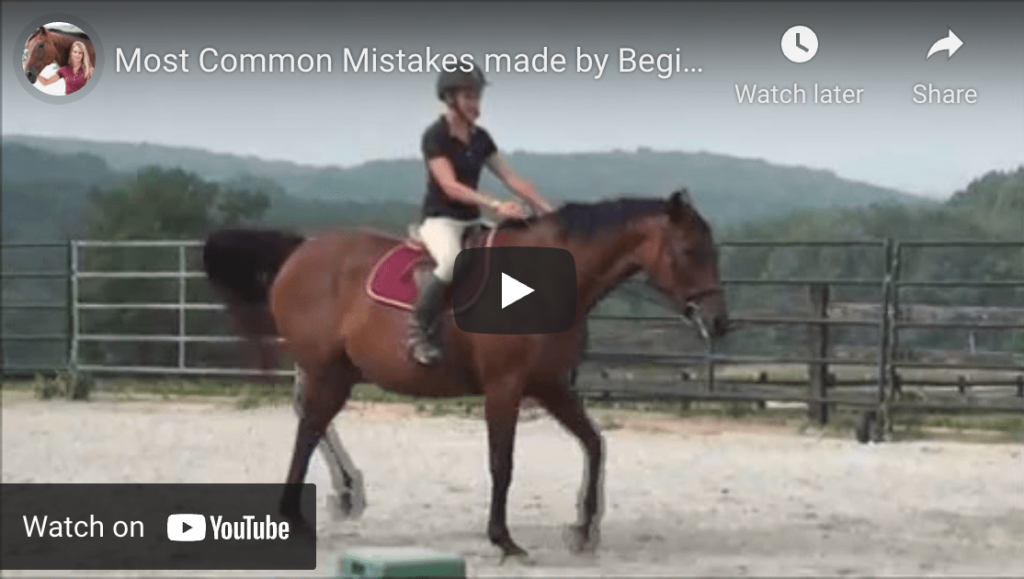
Click to view video!
Return to Top
Fun Fact: Horse riding is the only Olympic sport that involves an animal as a partner!

Frequently Asked Questions
How do you ride a horse for the first time?
The safest way is to take riding lessons with a professional instructor, or on an escorted trail ride. Don't attempt to do it by yourself. Reference the article above for helpful advice along the way.
Is it hard to ride a horse?
Riding a horse is a skill, just like riding a bike. And, like riding a bike, you need more experience to try more difficult maneuvers. Riding a bike along a flat sidewalk with no bumps or traffic is something that most people can learn to do.
Riding a mountain bike up and down hills and over obstacles takes a lot of practice and physical training to perform without injuries. It's the same with horses — riding at a walk is not that hard, but faster and more complicated activities require skill and practice.
How long does it take to learn to ride a horse?
Although one can argue that you can continue to learn riding your whole life, you can learn some basic skills and feel comfortable at a walk after several lessons.
If you're looking for a skill you can keep perfecting, riding can offer that — or you can learn to enjoy yourself with some basic education that helps you be safe and comfortable on the occasional trail ride.
How do you ride a horse fast?
By learning to ride a horse slow!
Seriously, the skills for going faster on a horse are built from learning to ride with balance and coordination, as well as developing your muscle memory and understanding how horses move.
As you improve your riding at a walk and trot, you'll become ready to canter and gallop.

What are some horse riding tips for trotting?
Relax, don't grip with your knees, and did we mention RELAX? For additional tips about how to improve your ability to sit at a trot, check out this video:

Click to watch video!
How do you ride a horse English style?
English riding involves English style tack — saddle, bridle, accessories — and is different from Western style riding. For starters, the rider uses a smaller saddle, doesn't sit as deeply in the saddle, and uses both reins to guide the horse.
If you'd like to watch a video of a horse having its English tack put on, this is a good one:

Click to view video!
How do you ride a horse western style?
Western-style riding is based on how working cowboys needed to ride to perform their work.
You'll see heavier saddles with a horn to tie a rope to, a deeper riding seat, and longer stirrups that make long hours in the saddle more secure and comfortable. The rider holds the reins in one hand — so that the other can throw a rope.
Here's a video that shows Western style tack being put on a horse:
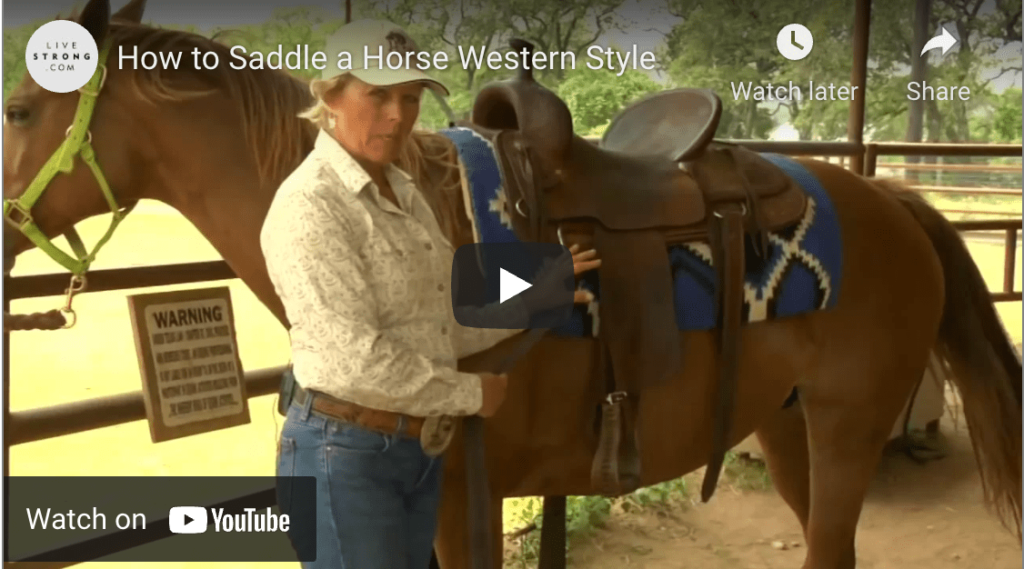
Click to view video!
What is the best breed of horse for first-time owners?
Check out our article about the best breeds of horses for first-time owners.
What is the best breed of horse for beginners?
Check out our article about the best breeds of horses for beginners.

What are some beginner horse riding exercises?
To help yourself get fit for riding, focus on strengthening your whole body — it's really a workout! However, most new riders find that they need work on their legs and core muscles.
Work on walking stairs, strengthening your abductor muscles, sit-ups, and planks. You'll also find our blog about 5 Yoga Poses for Equestrians instructive.
Or, check out this rider fitness video for additional tips:
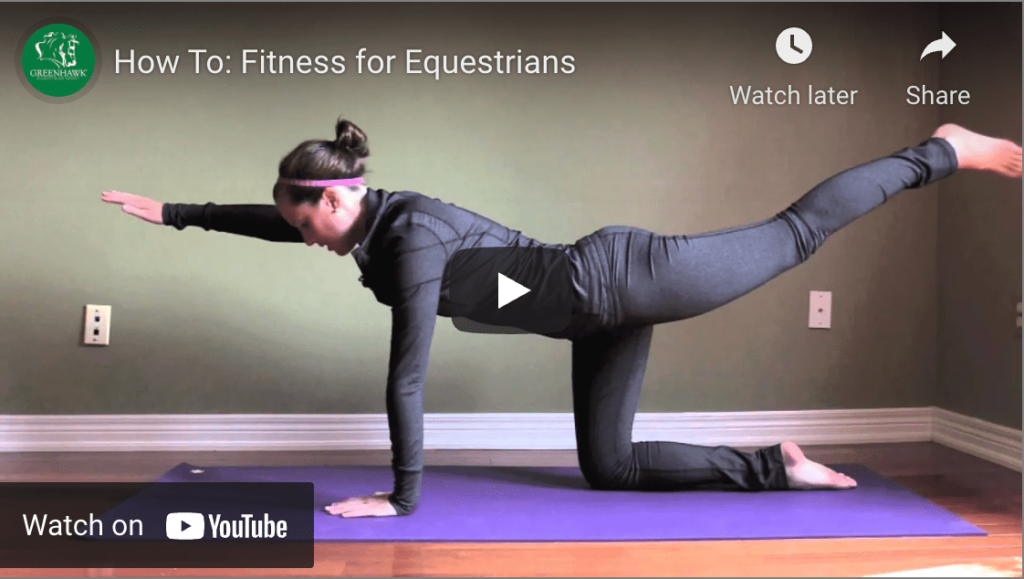
Click to view video!
What are some horse riding tips for the canter?
Let your hips move freely, remember that there is a steady three-beat rhythm involved, and don't interfere with the movement of your horse's head.
Remember, once you are skilled enough to canter, you will be using smaller and more refined cues to help guide your horse — and the ability to perform them will take time and practice.
Check out the cantering section above for more tips.
What are some first horse riding lesson tips?
Enjoy yourself, remember that you will get dirty, and make sure your clothing and gear fit properly. Even for a short ride, warm up by doing some stretches – you'll be using some different muscles.
Make sure you have the best boots for horseback riding lessons, too!
What do I need to ride a horse?
Check out our horse riding equipment list for beginners.
How many horse riding lessons do you need before you canter?
Think in terms of months, not weeks. It will all depend on your natural skills, the amount of time you're putting in, and your instructor. It's best to talk to your instructor about what they think the timeline might be after you've had a few lessons together.
You can certainly learn to walk on a horse in a week, but riding is a real skill that you'll need time and practice to develop. Visit a riding school and talk to the instructor about lesson options.
Just like riding a bike, it's impossible to learn to ride a horse in a day. Don't let that discourage you from trying out a short trail ride on a calm horse, or taking your first introductory riding class. You'll find out how fun and addictive learning to ride can be!
Also like riding a bike, you'll always remember the basic skills that riding involves, once you've mastered them. Bear in mind though – each horse is different, and there are many different styles of riding out there.
Return to Top

You CAN Ride a Horse… With Practice!
Riding horses well takes years (often decades!) of practice. It can be hard to see progress when you're just starting out, but hang in there. As with everything in life, practice makes progress (not perfection).
Treat riding as a sport, and remember that it's physical and can be hard work.
No matter what, you're dealing with another being that has opinions, feelings, and who also has good and bad days, just as you do. Always thank your mount for their hard work by interacting with them in a positive way — scratches, gentle pats, and carrots are good ways to show your appreciation!
P.S. Enjoy this article? Trot on over to:
- How Much Horses Cost & How You Can Afford One
- Friendly & Fun: 4 Best Horse Breeds for Beginners
- 60 Questions to Ask When Buying the Horse of Your Dreams
- 13 Best Boots for Horseback Riding Lessons
- 8 Best Horse Riding Helmets for Hot Weather
- Horseback Riding: What to Wear (With Pictures)
- Horseback Riding Safety Equipment That's Worth Every Penny
Shop Horse Rookie Riding Essentials
How to Get a Horse Ready to Ride
Source: https://horserookie.com/how-to-ride-a-horse-for-beginners/
0 Response to "How to Get a Horse Ready to Ride"
Post a Comment